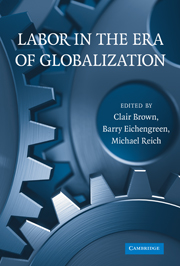Book contents
- Frontmatter
- Contents
- Tables and Figures
- List of Authors and Editors
- Introduction: Labor in the Era of Globalization
- PART ONE POLITICAL ECONOMY AND LABOR MARKET INSTITUTIONS
- PART TWO INSTITUTIONS AND FIRM AND WORKER BEHAVIOR
- PART THREE CONTEMPORARY LABOR–MANAGEMENT RELATIONS
- 7 The New Treaty of Detroit: Are VEBAs Labor's Way Forward?
- 8 Symphony Musicians and Symphony Orchestras
- 9 Wage Effects of Works Councils and Collective Agreements in Germany
- 10 Apprentice Strikes, Pay Structure, and Training in the Twentieth-Century UK Metalworking Industry
- PART FOUR PUBLIC POLICY AND U.S. LABOR-MARKET STRUCTURE
- Index
- References
7 - The New Treaty of Detroit: Are VEBAs Labor's Way Forward?
Published online by Cambridge University Press: 05 June 2012
- Frontmatter
- Contents
- Tables and Figures
- List of Authors and Editors
- Introduction: Labor in the Era of Globalization
- PART ONE POLITICAL ECONOMY AND LABOR MARKET INSTITUTIONS
- PART TWO INSTITUTIONS AND FIRM AND WORKER BEHAVIOR
- PART THREE CONTEMPORARY LABOR–MANAGEMENT RELATIONS
- 7 The New Treaty of Detroit: Are VEBAs Labor's Way Forward?
- 8 Symphony Musicians and Symphony Orchestras
- 9 Wage Effects of Works Councils and Collective Agreements in Germany
- 10 Apprentice Strikes, Pay Structure, and Training in the Twentieth-Century UK Metalworking Industry
- PART FOUR PUBLIC POLICY AND U.S. LABOR-MARKET STRUCTURE
- Index
- References
Summary
Fringe benefits are of importance to such fundamental labor market problems as the social organization of work and production, as well as to social and moral obligations of citizens … They deserve more attention than they have generally received from the economic research community.
Sherwin Rosen (2000: 29)The United Autoworkers of America (UAW) struck General Motors (GM) on September 24, 2007, for forty hours, in its first nationwide strike against the company in thirty-seven years. When negotiations broke down, UAW President Ron Gettelfinger quickly assured the media that the impasse was not about retiree health care – that is, not a mandatory subject of bargaining. This, of course, was a strong clue that the strike was largely about the car company's role in providing a promised benefit to people no longer working for it. When the news broke that the autoworkers had agreed to transfer their retiree health-care benefits from an (unfunded) defined benefit (DB) plan to a funded defined contribution (DC) plan, the Wall Street Journal called the settlement on retiree health-care plans the most important concession the union made.
The UAW had agreed that the company would transfer responsibility for retiree health care to a trust fund called a Voluntary Employee Benefits Association (VEBA). Having agreed to the VEBA, the union held out for compensatory job-security language and for sufficient funding for the VEBA. Ford and Chrysler, in typical pattern-bargaining behavior, followed and negotiated similar agreements.
- Type
- Chapter
- Information
- Labor in the Era of Globalization , pp. 241 - 263Publisher: Cambridge University PressPrint publication year: 2009



